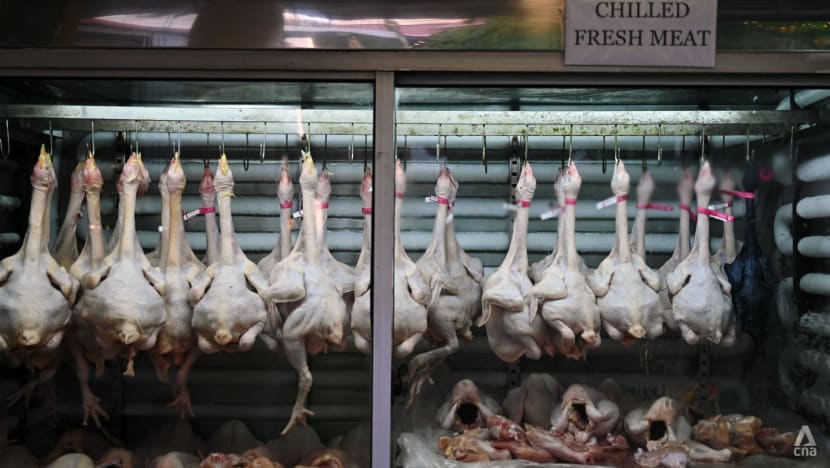As inflation pushes up chicken prices, wet market stalls see up to 50% fewer customers
The drop in demand for chicken was noticeable over the Chinese New Year period, stallholders say.

Fresh chicken displayed at a poultry stall at Tiong Bahru Market on Jun 01, 2022. (Photo: CNA/Marcus Mark Ramos)
SINGAPORE: Amid rising prices and a shortage in supply, sales of chicken fell significantly over Chinese New Year, importers and sellers said.
Stallholders selling chicken at wet markets that CNA visited on Tuesday (Jan 31) said business was noticeably quieter over the festive period. Some saw up to 50 per cent fewer customers.
But they pegged the price increase to several causes, including inflation and Malaysia’s chicken export ban which was implemented in June last year to address the country’s domestic supply shortage.
The export ban was only partially lifted in October for live broiler chickens.
At the same time, chicken prices have been hit by rising inflation.
Singapore's food inflation rose to 7.5 per cent in December, official figures released last week showed. In particular, meat prices were 14.7 per cent higher compared with the same month in 2021.
A whole chilled chicken now costs an average of S$8.91 per kg, according to December data from the Singapore Department of Statistics. This compares to S$7.22 per kg in May, before Malaysia's ban, and S$8.39 in June when the ban kicked in.
The cost of chilled chicken wings rose from S$10.43 per kg in May to S$11.67 in December.
SELLERS SEE DROP IN SALES
Fu Lai Fa at Bukit Merah View Market, which sells fresh chicken, saw about 30 to 40 per cent fewer customers during the festive period.
There were about 20 per cent fewer customers at Swee Heng Fresh Chicken Shop at Beo Crescent Market, which sells its fresh chicken for S$11 per kg.
Business at an adjacent stall, Kim Heng Frozen Food, was “not so good”, but its stallholder who only wanted to be known as Mr Tan said there wasn’t much price change for frozen chicken.
“During Chinese New Year, (the business) dropped. Very horrible, almost 50 per cent. And now with the CDC vouchers, people can go to the supermarket (to buy their chicken),” he said.
The Community Development Council (CDC) vouchers, issued last month to help households with cost of living increases, included S$150 of vouchers – half of the total – that can be spent at participating supermarkets. Previous tranches of the vouchers could only be used at hawkers and heartland shops.
Mr Tan added that he was “lucky” to be semi-retired, and was running his stall to "pass time", unlike other stallholders who may depend on a constant flow of customers.
But some customers at these stalls didn’t begrudge the stallholders for increasing their prices, continuing to visit at least once a week.
A 67-year-old customer, who gave his name as Mr Liew, said sellers have “no choice but to raise the price” if suppliers increase prices on their end. Nonetheless he visits Swee Heng Fresh Chicken Shop twice to thrice a week.
Another customer at the same stall, Ms Maoko Yasuda, said her family’s chicken consumption habits hadn’t changed despite the price increase. Even though “the price is very high, it’s okay”, said the 36-year-old mother.
SUPERMARKET SUPPLY OF MALAYSIA CHICKEN NOT AT PRE-BAN LEVELS
Chicken imports from Malaysia have not resumed to pre-ban levels across the industry at supermarket chains either.
At NTUC FairPrice, a spokesperson told CNA that the company has ramped up supplies from other markets, including Indonesia, Thailand and Brazil, to close the gap.
The rise in chicken prices can be attributed to various factors such as the "higher cost of chicken feed, logistics, manpower shortages and volatile market conditions".
The spokesperson added that while Malaysia chicken prices have risen, Brazil and Thailand prices remained stable.
There is also steady growth in customer demand for Indonesia chicken, FairPrice said.
The sales volume of chicken at Sheng Siong is “lower than before”, “in large part because the supply has yet to fully resume”, its spokesperson said.
But the supermarket has not yet seen a “significant impact” on demand, even though prices for fresh chicken have risen from the period before Malaysia’s ban to after the partial lifting of the ban.
The “inverse relationship between demand and price generally holds” across other meat products, the company said.
“More time may be needed to really discern if there has been a change in the consumers’ preference for chicken due to the price adjustments,” it added.
HIGH COST OF REARING CHICKENS
Poultry importers suggested that the rising prices were the result of the higher cost of rearing chickens.
“If the cost of chicken feed drops, then ultimately the cost of chicken will drastically reduce. If the feed is expensive, poultry cost will be on the high side,” said Mr James Sim, chief marketing officer for chicken importer Kee Song Food.
“Once chicken feed costs increase, farmers tend to rear less chicken. Then (it’s an issue of) demand and supply. If (demand is) not met, ultimately the cost of chicken will go up.”
Mr Sim noted that “consumption of chicken has reduced” over the recent Chinese New Year period, probably because customers have “other choices” of meat, such as fish, pork, beef or mutton.
“Chicken used to be the cheapest protein among the rest of the meat. The demand is still there, but not as much as before,” he said.
Mr Ma Chin Chew, CEO of Hup Heng Poultry Industries, said the partial resumption in supply from Malaysia is “not enough to fulfil demand for the market”.
“With the current COVID-19 issue and raw material price issue, I don’t think suppliers will reduce the price. Because of all the uncertainty, and the permit (to export chicken) is based on a monthly basis, no farmer will want to raise more chicken,” he said.
Mr Ma added that it is inevitable for the effects of inflation to trickle down to the consumer, after retailers factor in the price hike.


















